Concrete Additive Manufacturing in Construction: Integration Based on Component-Related Fabrication Strategies
Abstract
1. Introduction
1.1. Current Situation and Problem Statement
1.2. Aim and Scope of This Paper
2. Review of Concrete Additive Manufacturing (CoAM)
2.1. Classification of AM Processes
- Formative manufacturing processes
- Subtractive manufacturing processes
- Additive manufacturing processes.
2.2. Characteristics of AM Methods
2.2.1. Extrusion-Based CoAM

2.2.2. Spraying-Based CoAM
2.2.3. Particle Bed CoAM
- Selective cement activation (SCA): The particle bed contains a dry mixture of fine aggregate (typically sand ≤ 1 mm) and cement (activator) into which water and, if necessary, admixtures are selectively introduced for local cement activation. A cement paste matrix is formed around the aggregate particles [45].
- Selective paste intrusion (SPI): Only the aggregate (average diameter ≤ 5 mm) is present in the particle bed into which a flowable cement paste, with other admixtures, if necessary, is selectively deposited and infiltrates the voids between the aggregate particles [45].
- Binder jetting (BJ): Similar to the SCA process, binder jetting involves the dry mixing of an aggregate and a binder (activator). A resin is selectively applied to bond the layers together. As the activator is a polymer, this is not a cement-based process but a polymer-sand composite process [45].
2.2.4. Hybrid Concrete Additive Manufacturing Methods
2.3. Comparison and Assessment
3. Methodology
4. Fabrication Strategies for Additively Manufactured Concrete Components
4.1. Predominantly Compression-Stressed Components
4.1.1. Walls
- Extrusion-based fabrication strategies:

- The type of internal structure (e.g., stiffened grid or equivalent pattern)
- The type of use (indirectly used as lost formwork with or without in-situ reinforced concrete or as a directly used structural component)
- The type of load bearing (reinforced or unreinforced)
- The functional integration (e.g., insulating or electrical cabling)
- The surface finish (ornamentation or quality of the exposed concrete)
- Spraying-based fabrication strategies:
4.1.2. Columns
- Extrusion-based fabrication strategies:
- Spraying-based fabrication strategies:
- (1)
- concrete supports reinforcement
- (2)
- reinforcement supporting concrete
4.2. Predominantly Bending-Stressed Components
4.2.1. Slabs
- Particle-bed-based fabrication strategies:
- Extrusion-based fabrication strategies:
- Spraying-based fabrication strategies:
- “Direct” prefabrication of topology-optimised slabs as small components (Particle Bed).
- “Indirect” prefabrication of topology-optimised slabs using 3D printed hollow elements to place as recesses. It was shown that extrusion was only used indirectly instead of printing a “slab” directly (Extrusion).
- Prefabrication of (structural optimised) slabs as “add-on” printing using already prefabricated semi-finished slabs or modern formwork solution as a counterpart (Spraying).
4.2.2. Beams
- V1: The beam is printed along the longitudinal axis (0°—no rotation)
- V2: The beam is produced segmented and then joined by external post-tensioning. (90° individual segments rotated around the x-axis).
- V3: The beam is not segmented and is printed as a “column” and conventionally reinforced with steel bars or subsequently post-tensioning. The “column” is then laid down as a “beam”.
- V4: The beam is flipped along the longitudinal axis and printed (component rotated 90° around the y-axis; placed sideways).
- Particle-bed-based fabrication strategies:
- Extrusion-based fabrication strategies:
- Spraying-based fabrication strategies:
5. Discussion: Trends, Potential and Future Challenges
5.1. Extrusion Based CoAM
5.2. Spraying-Based CoAM
5.3. Particle-Bed-Based CoAM
6. Conclusions
6.1. Summary
6.2. Outlook
- How will a “design for AM” approach effect the conventional design and construction process?
- How will the design process change if AM-specific structural-design requirements are integrated into the early design stages?
- What is the appropriate manufacturing process to use? (conventional or AM?)
- When does the selection of a construction method have to be made in the design process?
Author Contributions
Funding
Data Availability Statement
Acknowledgments
Conflicts of Interest
References
- Lehne, J.; Preston, F. Making Concrete Change: Innovation in Low-carbon Cement and Concrete. 2018. Available online: https://www.chathamhouse.org/2018/06/making-concrete-change-innovation-low-carbon-cement-and-concrete (accessed on 18 April 2023).
- Statista. Cement Production Global 2022|Statista. Available online: https://www.statista.com/statistics/1087115/global-cement-production-volume/ (accessed on 22 March 2023).
- International Energy Agency; World Business Council for Sustainable Development’s (WBCSD) Cement Sustainability Initiative. Technology Roadmap: Low-Carbon Transition in the Cement Industry. 2018. Available online: https://www.wbcsd.org/contentwbc/download/4586/61682/1 (accessed on 18 April 2023).
- Bundesministerium für Umwelt, Naturschutz, Bau und Reaktorsicherheit (BMUB). Übereinkommen von Paris. Available online: https://www.bmuv.de/fileadmin/Daten_BMU/Download_PDF/Klimaschutz/paris_abkommen_bf.pdf (accessed on 18 April 2023).
- Hauptverband der Deutschen Bauindustrie. Produktivität im Bau(haupt-)gewerbe—Ein Statistischer Befund. Available online: https://www.bauindustrie.de/fileadmin/bauindustrie.de/Zahlen_Fakten/Auf_den_Punkt_gebracht/221102_Bi_auf_den_Punkt_gebracht_-_Produktivitaet_im_Bau_haupt_gewerbe_01.pdf (accessed on 22 March 2023).
- McKinsey Global Institute. Reinventing Construction: A Route to Higher Productivity. Available online: https://www.mckinsey.com/~/media/mckinsey/business%20functions/operations/our%20insights/reinventing%20construction%20through%20a%20productivity%20revolution/mgi-reinventing-construction-a-route-to-higher-productivity-full-report.pdf (accessed on 18 April 2023).
- García de Soto, B.; Agustí-Juan, I.; Hunhevicz, J.; Joss, S.; Graser, K.; Habert, G.; Adey, B.T. Productivity of digital fabrication in construction: Cost and time analysis of a robotically built wall. Autom. Constr. 2018, 92, 297–311. [Google Scholar] [CrossRef]
- De Schutter, G.; Lesage, K.; Mechtcherine, V.; Nerella, V.N.; Habert, G.; Agusti-Juan, I. Vision of 3D printing with concrete—Technical, economic and environmental potentials. Cem. Concr. Res. 2018, 112, 25–36. [Google Scholar] [CrossRef]
- Delgado Camacho, D.; Clayton, P.; O’Brien, W.J.; Seepersad, C.; Juenger, M.; Ferron, R.; Salamone, S. Applications of additive manufacturing in the construction industry—A forward-looking review. Autom. Constr. 2018, 89, 110–119. [Google Scholar] [CrossRef]
- Placzek, G.; Schwerdtner, P. Ableitung von Integrationsansätzen des “Beton-3D- Drucks“ in den Bauprozess anhand von Merkmalen der additiven Fertigung. Bauwirtschaft 2020, 5, 208–222. [Google Scholar]
- Kloft, H.; Hack, N.; Mainka, J.; Brohmann, L.; Herrmann, E.; Ledderose, L.; Lowke, D. Additive Fertigung im Bauwesen: Erste 3-D-gedruckte und bewehrte Betonbauteile im Shotcrete-3-D-Printing-Verfahren (SC3DP). Bautechnik 2019, 96, 929–938. [Google Scholar] [CrossRef]
- El-Sayegh, S.; Romdhane, L.; Manjikian, S. A critical review of 3D printing in construction: Benefits, challenges, and risks. Arch. Civ. Mech. Eng. 2020, 20, 4. [Google Scholar] [CrossRef]
- Baigarina, A.; Shehab, E.; Ali, M.H. Construction 3D printing: A critical review and future research directions. Prog. Addit. Manuf. 2023. [Google Scholar] [CrossRef]
- Strohle, M.; Sadique, M.; Dulaimi, A.; Kadhim, M.A. Prospect and barrier of 3D concrete: A systematic review. Innov. Infrastruct. Solut. 2023, 8, 21. [Google Scholar] [CrossRef]
- Kaszyńska, M.; Skibicki, S.; Hoffmann, M. 3D Concrete Printing for Sustainable Construction. Energies 2020, 13, 6351. [Google Scholar] [CrossRef]
- Al-Tamimi, A.K.; Alqamish, H.H.; Khaldoune, A.; Alhaidary, H.; Shirvanimoghaddam, K. Framework of 3D Concrete Printing Potential and Challenges. Buildings 2023, 13, 827. [Google Scholar] [CrossRef]
- Bhardwaj, A.; Jones, S.Z.; Kalantar, N.; Pei, Z.; Vickers, J.; Wangler, T.; Zavattieri, P.; Zou, N. Additive Manufacturing Processes for Infrastructure Construction: A Review. J. Manuf. Sci. Eng. 2019, 141, 091010. [Google Scholar] [CrossRef]
- Shakor, P.; Nejadi, S.; Paul, G.; Malek, S. Review of Emerging Additive Manufacturing Technologies in 3D Printing of Cementitious Materials in the Construction Industry. Front. Built Environ. 2019, 4, 2740. [Google Scholar] [CrossRef]
- Ma, G.; Wang, L. A critical review of preparation design and workability measurement of concrete material for largescale 3D printing. Front. Struct. Civ. Eng. 2018, 12, 382–400. [Google Scholar] [CrossRef]
- Paul, S.C.; van Zijl, G.P.; Tan, M.J.; Gibson, I. A review of 3D concrete printing systems and materials properties: Current status and future research prospects. RPJ 2018, 24, 784–798. [Google Scholar] [CrossRef]
- Puzatova, A.; Shakor, P.; Laghi, V.; Dmitrieva, M. Large-Scale 3D Printing for Construction Application by Means of Robotic Arm and Gantry 3D Printer: A Review. Buildings 2022, 12, 2023. [Google Scholar] [CrossRef]
- Chen, H.; Zhang, D.; Chen, P.; Li, N.; Perrot, A. A Review of the Extruder System Design for Large-Scale Extrusion-Based 3D Concrete Printing. Materials 2023, 16, 2661. [Google Scholar] [CrossRef]
- Cao, X.; Yu, S.; Cui, H.; Li, Z. 3D Printing Devices and Reinforcing Techniques for Extruded Cement-Based Materials: A Review. Buildings 2022, 12, 453. [Google Scholar] [CrossRef]
- Wu, Z.; Memari, A.; Duarte, J. State of the Art Review of Reinforcement Strategies and Technologies for 3D Printing of Concrete. Energies 2022, 15, 360. [Google Scholar] [CrossRef]
- Ahmed, G.H.; Askandar, N.H.; Jumaa, G.B. A review of largescale 3DCP: Material characteristics, mix design, printing process, and reinforcement strategies. Structures 2022, 43, 508–532. [Google Scholar] [CrossRef]
- Paolini, A.; Kollmannsberger, S.; Rank, E. Additive manufacturing in construction: A review on processes, applications, and digital planning methods. Addit. Manuf. 2019, 30, 100894. [Google Scholar] [CrossRef]
- Raphael, B.; Senthilnathan, S.; Patel, A.; Bhat, S. A review of concrete 3D printed structural members. Front. Built Environ. 2023, 8, 291. [Google Scholar] [CrossRef]
- Tay, Y.W.D.; Panda, B.; Paul, S.C.; Noor Mohamed, N.A.; Tan, M.J.; Leong, K.F. 3D printing trends in building and construction industry: A review. Virtual Phys. Prototyp. 2017, 12, 261–276. [Google Scholar] [CrossRef]
- Zhang, J.; Wang, J.; Dong, S.; Yu, X.; Han, B. A review of the current progress and application of 3D printed concrete. Compos. Part A Appl. Sci. Manuf. 2019, 125, 105533. [Google Scholar] [CrossRef]
- Hossain, M.A.; Zhumabekova, A.; Paul, S.C.; Kim, J.R. A Review of 3D Printing in Construction and its Impact on the Labor Market. Sustainability 2020, 12, 8492. [Google Scholar] [CrossRef]
- Peri. PERI Group Acquires Stake in COBOD International A/S. Available online: https://www.peri.com/en/company/press-releases/PERI-Group-acquires-stake-in-COBOD.html (accessed on 22 March 2023).
- Meisenzahl, M.; Dubai Is Now Home to the Largest 3D-Printed Building in the World. Insider [Online]; 30 December 2019. Available online: https://www.businessinsider.com/dubai-largest-3d-printed-building-apis-cor-photos-2019-12 (accessed on 25 April 2023).
- 3dprintedhouse. Project Milestone. Available online: https://www.3dprintedhouse.nl/en/project-info/project-milestone/ (accessed on 25 April 2023).
- COBOD. Kamp C|COBOD International. Available online: https://cobod.com/projects-partners/kamp-c/ (accessed on 25 April 2023).
- Brooke Bauguess. The Chicon House—ICON: The First Permitted 3D-Printed Home in the United States. Available online: https://www.iconbuild.com/projects/chicon-house (accessed on 25 April 2023).
- PERI 3D Construction GmbH. Germany’s First 3D-Printed Home. Available online: https://www.peri3dconstruction.com/en/beckum (accessed on 25 April 2023).
- PERI 3D Construction GmbH. Europe’s Largest 3D-Printed Apartment Building. Available online: https://www.peri3dconstruction.com/en/wallenhausen (accessed on 25 April 2023).
- Statistisches Bundesamt. Baufertigstellungen von Wohungen in Wohn- und Nichtwohngebäuden* in Deutschland in den Jahren 2022 bis 2021 (in Tausend) [Graph]. Available online: https://de.statista.com/statistik/daten/studie/39008/umfrage/baufertigstellungen-von-wohnungen-in-deutschland/ (accessed on 25 April 2023).
- Bos, F.P.; Menna, C.; Pradena, M.; Kreiger, E.; da Silva, W.L.; Rehman, A.U.; Weger, D.; Wolfs, R.; Zhang, Y.; Ferrara, L.; et al. The realities of additively manufactured concrete structures in practice. Cem. Concr. Res. 2022, 156, 106746. [Google Scholar] [CrossRef]
- Gebhardt, A. Generative Fertigungsverfahren: Additive Manufacturing und 3D Drucken für Prototyping-Tooling-Produktion, 4., neu bearb. und erw. Aufl. In Hanser; Ciando: München, Germany, 2013; ISBN 9783446436527. [Google Scholar]
- DIN Deutsches Institut für Normung e., V. DIN 8580:2022-12, Fertigungsverfahren—Begriffe, Einteilung; Beuth Verlag GmbH: Berlin, Germany, 2022. [Google Scholar]
- Buswell, R.A.; Bos, F.P.; Silva, W.R.L.d.; Hack, N.; Kloft, H.; Lowke, D.; Freund, N.; Fromm, A.; Dini, E.; Wangler, T.; et al. Digital Fabrication with Cement—Based Materials: Process Classification and Case Studies. In Digital Fabrication with Cement-Based Materials; Springer: Cham, Switzerland, 2022; pp. 11–48. [Google Scholar]
- Buswell, R.A.; da Silva, W.L.; Bos, F.P.; Schipper, H.R.; Lowke, D.; Hack, N.; Kloft, H.; Mechtcherine, V.; Wangler, T.; Roussel, N. A process classification framework for defining and describing Digital Fabrication with Concrete. Cem. Concr. Res. 2020, 134, 106068. [Google Scholar] [CrossRef]
- DIN Deutsches Institut für Normung e., V. DIN EN ISO/ASTM 52900:2022-03, Additive Fertigung-Grundlagen-Terminologie: Deutsche Fassung EN_ISO/ASTM 52900:2021; Beuth Verlag GmbH: Berlin, Germany, 2022. [Google Scholar]
- Lowke, D.; Dini, E.; Perrot, A.; Weger, D.; Gehlen, C.; Dillenburger, B. Particle-bed 3D printing in concrete construction—Possibilities and challenges. Cem. Concr. Res. 2018, 112, 50–65. [Google Scholar] [CrossRef]
- Volpe, S.; Sangiorgio, V.; Fiorito, F.; Varum, H. Overview of 3D construction printing and future perspectives: A review of technology, companies and research progression. Archit. Sci. Rev. 2022, 1–22. [Google Scholar] [CrossRef]
- Lim, S.; Buswell, R.; Le, T.; Wackrow, R.; Austin, S.; Gibb, A.; Thorpe, T. Development of a Viable Concrete Printing Process. In Proceedings of the 28th ISARC, 28th International Symposium on Automation and Robotics in Construction, Seoul, Republic of Korea, 29 June–2 July 2011; Kwon, S., Ed.; [Google Scholar]
- Khoshnevis, B.; Dutton, R. Innovative Rapid Prototyping Process Makes Large Sized, Smooth Surfaced Complex Shapes in a Wide Variety of Materials. Mater. Technol. 1998, 13, 53–56. [Google Scholar] [CrossRef]
- Khoshnevis, B. Automated construction by contour crafting—Related robotics and information technologies. Autom. Constr. 2004, 13, 5–19. [Google Scholar] [CrossRef]
- Mechtcherine, V.; Nerella, V.N. Beton-3D-Druck durch selektive Ablage. Beton-Stahlbetonbau 2019, 114, 24–32. [Google Scholar] [CrossRef]
- Lim, S.; Buswell, R.A.; Le, T.T.; Austin, S.A.; Gibb, A.; Thorpe, T. Developments in construction-scale additive manufacturing processes. Autom. Constr. 2012, 21, 262–268. [Google Scholar] [CrossRef]
- Otto, J.; Krause, M. CONPrint3D®: 3D-Druck als Innovation im Betonbau. In Festschrift zum 60. Geburtstag von Univ.-Prof. Dr.-Ing. Christoph Motzko; Fenner, J., Ed.; Institut für Baubetrieb der Technischen Universität Darmstadt: Darmstadt, Germany, 2017; pp. 571–586. ISBN 978-3-941925-29-8. [Google Scholar]
- Le, T.T.; Austin, S.A.; Lim, S.; Buswell, R.A.; Gibb, A.G.F.; Thorpe, T. Mix design and fresh properties for high-performance printing concrete. Mater. Struct. 2012, 45, 1221–1232. [Google Scholar] [CrossRef]
- Buswell, R.A.; Leal de Silva, W.R.; Jones, S.Z.; Dirrenberger, J. 3D printing using concrete extrusion: A roadmap for research. Cem. Concr. Res. 2018, 112, 37–49. [Google Scholar] [CrossRef]
- Alfani, R. Rheological test methods for the characterization of extrudable cement-based materials—A review. Mater. Struct. 2005, 38, 239–247. [Google Scholar] [CrossRef]
- Marchment, T.; Sanjayan, J.; Xia, M. Method of enhancing interlayer bond strength in construction scale 3D printing with mortar by effective bond area amplification. Mater. Des. 2019, 169, 107684. [Google Scholar] [CrossRef]
- Van der Putten, J.; Volder, M.d.; van den Heede, P.; Deprez, M.; Cnudde, V.; Schutter, G.d.; van Tittelboom, K. Transport properties of 3D printed cementitious materials with prolonged time gap between successive layers. Cem. Concr. Res. 2022, 155, 106777. [Google Scholar] [CrossRef]
- Placzek, G.; Schwerdtner, P. Vorüberlegungen bei der Anwendung robotischer Systeme—Eine baubetriebliche Untersuchung für den Beton-3D-Druck/A preliminary study of the impact of robotic systems on concrete 3D printing in the construction industry. Bauingenieur 2022, 97, 423–433. [Google Scholar] [CrossRef]
- Dörfler, K.; Hack, N.; Sandy, T.; Giftthaler, M.; Lussi, M.; Walzer, A.N.; Buchli, J.; Gramazio, F.; Kohler, M. Mobile robotic fabrication beyond factory conditions: Case study Mesh Mould wall of the DFAB HOUSE. Constr. Robot. 2019, 3, 53–67. [Google Scholar] [CrossRef]
- Labonnote, N.; Rønnquist, A.; Manum, B.; Rüther, P. Additive construction: State-of-the-art, challenges and opportunities. Autom. Constr. 2016, 72, 347–366. [Google Scholar] [CrossRef]
- Apis Cor. Project “Frank” by Apis Cor. Available online: https://www.youtube.com/watch?v=NX2AQCLNXbU (accessed on 3 November 2021).
- Gosselin, C.; Duballet, R.; Roux, P.; Gaudillière, N.; Dirrenberger, J.; Morel, P. Large-scale 3D printing of ultra-high performance concrete—A new processing route for architects and builders. Mater. Des. 2016, 100, 102–109. [Google Scholar] [CrossRef]
- Bos, F.; Wolfs, R.; Ahmed, Z.; Salet, T. Additive manufacturing of concrete in construction: Potentials and challenges of 3D concrete printing. Virtual Phys. Prototyp. 2016, 11, 209–225. [Google Scholar] [CrossRef]
- Vasilic, K.; Norman, H.; Kloft, H.; Lowke, D.; Mechtcherine, V.; Nerella, V.N.; Wangler, T. Digitale Fertigung im Betonbau. In Nachhaltigkeit, Digitalisierung, Instandhaltung; 111; Jahrgang, Bergmeister, K., Fingerloos, F., Wörner, J.-D., Eds.; Ernst & Sohn a Wiley Brand: Berlin, Germany, 2022; pp. 691–724. ISBN 978-3-433-03344-9. [Google Scholar]
- AM Chronicle Editor. COBOD Showcases 3D Construction Printing Technology Live at Scale—AM Chronicle. Available online: https://www.amchronicle.com/news/cobod-3d-prints-construction-applications-live-in-front-of-record-breaking-audience-at-the-world-of-concrete-2022-in-las-vegas/ (accessed on 24 March 2023).
- XtreeE. 3D Printing System—XtreeE. Available online: https://xtreee.com/en/solutions/ (accessed on 24 March 2023).
- We Redefine Construction | CyBe Construction. Available online: https://cybe.eu/ (accessed on 24 March 2023).
- Lindemann, H.; Gerbers, R.; Ibrahim, S.; Dietrich, F.; Herrmann, E.; Dröder, K.; Raatz, A.; Kloft, H. Development of a Shotcrete 3D-Printing (SC3DP) Technology for Additive Manufacturing of Reinforced Freeform Concrete Structures. In First RILEM International Conference on Concrete and Digital Fabrication—Digital Concrete 2018; RILEM International Conference on Concrete and Digital Fabrication; Wangler, T., Flatt, R.J., Eds.; Springer International Publishing: Cham, Switzerland, 2019; pp. 287–298. [Google Scholar]
- Herrmann, E.; Lindemann, H.; Kloft, H. Entwicklung einer robotergestützten Spritzbetontechnologie zur schalungslosen generativen Fertigung komplexer Betonbauteile am DBFL (Digital Building Fabrication Laboratory). In Proceedings of the Spritzbeton-Tagung 2018, Alpbach, Austria, 11–12 January 2018. [Google Scholar]
- Nolte, N.; Heidmann-Ruhz, M.; Krauss, H.-W.; Varady, P.; Budelmann, H.; Wolter, A. Entwicklung von Spritzbetonrezepturen mit Steuerbaren Eigenschaften für die Robotergestützte Additive Fertigung von Betonbauteilen. In Proceedings of the Spritzbeton-Tagung, Alpbach, Austria, 11–12 January 2018. [Google Scholar]
- Kloft, H.; Hack, N.; Lindemann, H.; Mainka, J. Shotcrete 3D Printing (SC3DP)—3D-Drucken von großformatigen Betonbauteilen. DBZ 2019, 2, 54–57. [Google Scholar]
- Kloft, H.; Krauss, H.-W.; Hack, N.; Herrmann, E.; Neudecker, S.; Varady, P.A.; Lowke, D. Influence of process parameters on the interlayer bond strength of concrete elements additive manufactured by Shotcrete 3D Printing (SC3DP). Cem. Concr. Res. 2020, 134, 106078. [Google Scholar] [CrossRef]
- Hack, N.; Kloft, H. Shotcrete 3D Printing Technology for the Fabrication of Slender Fully Reinforced Freeform Concrete Elements with High Surface Quality: A Real-Scale Demonstrator. In Second RILEM International Conference on Concrete and Digital Fabrication; Bos, F.P., Lucas, S.S., Wolfs, R.J., Salet, T.A., Eds.; Springer International Publishing: Cham, Switzerland, 2020; pp. 1128–1137. ISBN 978-3-030-49915-0. [Google Scholar]
- Dressler, I.; Freund, N.; Lowke, D. The Effect of Accelerator Dosage on Fresh Concrete Properties and on Interlayer Strength in Shotcrete 3D Printing. Materials 2020, 13, 374. [Google Scholar] [CrossRef] [PubMed]
- Lachmayer, L.; Dörrie, R.; Kloft, H.; Raatz, A. Process Control for Additive Manufacturing of Concrete Components. In Third RILEM International Conference on Concrete and Digital Fabrication; RILEM International Conference on Concrete and Digital Fabrication; Buswell, R., Blanco, A., Cavalaro, S., Kinnell, P., Eds.; Springer International Publishing: Cham, Switzerland, 2022; pp. 351–356. [Google Scholar]
- Kloft, H.; Empelmann, M.; Hack, N.; Herrmann, E.; Lowke, D. Reinforcement strategies for 3D-concrete-printing. Civ. Eng. Des. 2020, 2, 131–139. [Google Scholar] [CrossRef]
- Aeditive—Revolutionäre Effizienz im Betonbau. Aeditive—Revolutionäre Effizienz im Betonbau. Available online: https://www.aeditive.de/ (accessed on 5 January 2023).
- Heidarnezhad, F.; Zhang, Q. Shotcrete based 3D concrete printing: State of art, challenges, and opportunities. Constr. Build. Mater. 2022, 323, 126545. [Google Scholar] [CrossRef]
- Pegna, J. Application of Cementitious Bulk Materials to Site Processed Solid Freeform Construction. 1995. Available online: https://repositories.lib.utexas.edu/handle/2152/68688 (accessed on 5 January 2023).
- Mai, I.; Lowke, D.; Perrot, A. Fluid intrusion in powder beds for selective cement activation—An experimental and analytical study. Cem. Concr. Res. 2022, 156, 106771. [Google Scholar] [CrossRef]
- Additive Tectonics. Innovative Technologies and 3D Printed Architecture. Available online: https://www.additive-tectonics.com/ (accessed on 25 April 2023).
- Yu, S.; Du, H.; Sanjayan, J. Aggregate-bed 3D concrete printing with cement paste binder. Cem. Concr. Res. 2020, 136, 106169. [Google Scholar] [CrossRef]
- Mai, I.; Brohmann, L.; Freund, N.; Gantner, S.; Kloft, H.; Lowke, D.; Hack, N. Large Particle 3D Concrete Printing-A Green and Viable Solution. Materials 2021, 14, 6125. [Google Scholar] [CrossRef]
- Hack, N.; Dressler, I.; Brohmann, L.; Gantner, S.; Lowke, D.; Kloft, H. Injection 3D Concrete Printing (I3DCP): Basic Principles and Case Studies. Materials 2020, 13, 1093. [Google Scholar] [CrossRef] [PubMed]
- Kloft, H.; Dörfler, K.; Bährens, M.; Dielemans, G.; Diller, J.; Dörrie, R.; Gantner, S.; Hensel, J.; Keune, A.; Lowke, D.; et al. Die Forschungsinfrastruktur des SFB TRR 277 AMC Additive Fertigung im Bauwesen. Bautechnik 2022, 99, 758–773. [Google Scholar] [CrossRef]
- Wakisaka, T.; Furuya, N.; Inoue, Y.; Shiokawa, T. Automated construction system for high-rise reinforced concrete buildings. Autom. Constr. 2000, 9, 229–250. [Google Scholar] [CrossRef]
- Lohmeyer, G.C.O. Stahlbetonbau; Vieweg+Teubner Verlag: Wiesbaden, Germany, 1990. [Google Scholar]
- García-Alvarado, R.; Moroni-Orellana, G.; Banda-Pérez, P. Architectural Evaluation of 3D-Printed Buildings. Buildings 2021, 11, 254. [Google Scholar] [CrossRef]
- Weger, D.; Gehlen, C.; Korte, W.; Meyer-Brötz, F.; Scheydt, J.; Stengel, T. Building rethought—3D concrete printing in building practice. Constr. Robot. 2021, 5, 203–210. [Google Scholar] [CrossRef]
- Hoffmann, M.; Skibicki, S.; Pankratow, P.; Zieliński, A.; Pajor, M.; Techman, M. Automation in the Construction of a 3D-Printed Concrete Wall with the Use of a Lintel Gripper. Materials 2020, 13, 1800. [Google Scholar] [CrossRef]
- Apis Cor. World’s Largest 3D Printed Building | Apis Cor. Available online: https://www.apis-cor.com/dubai-project (accessed on 23 March 2022).
- SWNA. Available online: https://theswna.com/projects/the-curtained-wall (accessed on 27 March 2023).
- Prasittisopin, L.; Pongpaisanseree, K.; Jiramarootapong, P.; Snguanyat, C. Thermal and Sound Insulation of Large-Scale 3D Extrusion Printing Wall Panel. In Second RILEM International Conference on Concrete and Digital Fabrication; RILEM International Conference on Concrete and Digital Fabrication; Bos, F.P., Lucas, S.S., Wolfs, R.J., Salet, T.A., Eds.; Springer International Publishing: Cham, Switzerland, 2020; pp. 1174–1182. [Google Scholar]
- Jaugstetter, F. Design Tool for Extrusion Based Additive Manufacturing of Functionally Enhanced Lightweight Concrete Wall Elements. Master’s Thesis, TU Munich, Munich, Germany, 2020. [Google Scholar]
- Briels, D.; Kollmannsberger, S.; Leithner, F.; Matthäus, C.; Nouman, A.S.; Oztoprak, O.; Rank, E. Thermal Optimization of Additively Manufactured Lightweight Concrete Wall Elements with Internal Cellular Structure through Simulations and Measurements. Buildings 2022, 12, 1023. [Google Scholar] [CrossRef]
- Ramakrishnan, S.; Muthukrishnan, S.; Sanjayan, J.; Pasupathy, K. Concrete 3D printing of lightweight elements using hollow-core extrusion of filaments. Cem. Concr. Compos. 2021, 123, 104220. [Google Scholar] [CrossRef]
- Ivaniuk, E.; Müller, S.; Neef, T.; Mechtcherine, V. Strategies for Integrating Reinforcement Into 3D Concrete Printing at the TU Dresden. Open Conf. Proc. 2022, 1, 23–34. [Google Scholar] [CrossRef]
- Mechtcherine, V.; Buswell, R.; Kloft, H.; Bos, F.P.; Hack, N.; Wolfs, R.; Sanjayan, J.; Nematollahi, B.; Ivaniuk, E.; Neef, T. Integrating reinforcement in digital fabrication with concrete: A review and classification framework. Cem. Concr. Compos. 2021, 119, 103964. [Google Scholar] [CrossRef]
- Otto, J.; Kortmann, J.; Krause, M. Wirtschaftliche Perspektiven von Beton-3D-Druckverfahren. Beton- und Stahlbetonbau 2020, 115, 586–597. [Google Scholar] [CrossRef]
- Magazine, A.; Nidus3d 3D Prints First Multi-Storey Building in North America. DEVELOP3D [Online]; 15 September 2022. Available online: https://aecmag.com/news/nidus3d-3d-prints-first-multi-storey-building-in-north-america/ (accessed on 27 March 2023).
- Peri GmbH. Presseinformation: PERI 3D-Druckprojekt Beckum Gewinnt German Innovation Award. Available online: https://www.peri.com/de/unternehmen/presseinformationen/peri-3d-druckprojekt-beckum-gewinnt-german-innovation-award.html (accessed on 19 July 2022).
- Anton, A.; Reiter, L.; Wangler, T.; Frangez, V.; Flatt, R.J.; Dillenburger, B. A 3D concrete printing prefabrication platform for bespoke columns. Autom. Constr. 2021, 122, 103467. [Google Scholar] [CrossRef]
- Gaudillière, N.; Duballet, R.; Bouyssou, C.; Mallet, A.; Roux, P.; Zakeri, M.; Dirrenberger, J. Large-Scale Additive Manufacturing of Ultra-High-Performance Concrete of Integrated Formwork for Truss-Shaped Pillars. In Robotic Fabrication in Architecture, Art and Design 2018; Willmann, J., Block, P., Hutter, M., Byrne, K., Schork, T., Eds.; Springer International Publishing: Cham, Switzerland, 2019; pp. 459–472. ISBN 978-3-319-92293-5. [Google Scholar]
- Zhu, B.; Nematollahi, B.; Pan, J.; Zhang, Y.; Zhou, Z.; Zhang, Y. 3D concrete printing of permanent formwork for concrete column construction. Cem. Concr. Compos. 2021, 121, 104039. [Google Scholar] [CrossRef]
- Vertico. DDW 2021|Vertico. Available online: https://www.vertico.xyz/dutch-design-week-2021 (accessed on 5 January 2023).
- Anton, A.; Bedarf, P.; Yoo, A.; Dillenburger, B.; Reiter, L.; Wangler, T.; Flatt, R.J. Concrete Choreography: Prefabrication of 3D-Printed Columns. In Proceedings of the Fabricate 2020, London, UK, 9–12 September 2020. [Google Scholar] [CrossRef]
- Shaping a Digital Building Culture for Concrete 3D Printing. Available online: https://ethambassadors.ethz.ch/2020/02/11/shaping-a-digital-building-culture-for-concrete-3d-printing/ (accessed on 27 March 2023).
- Marquart, S.; This Hotel Is 3D Printed from Sand and Volcanic Ash. Futurism [Online]; 22 March 2016. Available online: https://futurism.com/hotel-3d-printed-sand-volcanic-ash (accessed on 27 March 2023).
- Affentranger 3DCP. Stützen: Schalungen für Stützen in Beton, Stützen mit Pilzkopf, Dekorative Stützen. Available online: https://www.affentranger3dcp.ch/anwendungen/stutzen (accessed on 27 March 2023).
- Kloft, H.; Empelmann, M.; Oettel, V.; Ledderose, L. Production of the first concrete and reinforced concrete columns by means of 3D printing with concrete. BFT Int. 2019, 6, 28–37. [Google Scholar]
- Lachmayer, L.; Dörrie, R.; Kloft, H.; Raatz, A. Automated shotcrete 3D printing—Printing interruption for extended component complexity. In Proceedings of the 38th International Symposium on Automation and Robotics in Construction, Dubai, United Arab Emirates, 11 February–11 April 2021; Feng, C., Linner, T., Brilakis, I., Eds.; [Google Scholar]
- Cobiax. Cobiax SL (Slim Line). Available online: https://www.cobiax.com/de/de/produkte/cobiax-el/ (accessed on 27 March 2023).
- Graser, K.; Baur, M.; Apolinarska, A.A.; Dörfler, K.; Hack, N.; Jipa, A.; Lloret-Fritschi, E.; Sandy, T.; Sanz-Pont, D.; Hall, D.; et al. DFAB House: A comprehensive demonstrator of digital fabrication in architecture. In Fabricate 2020; Making Resilient Architecture. Fabricate 2020 (Virtual); Burry, J., Sabin, J., Sheil, B., Skavara, M., Eds.; UCL Press: London, UK, 2020; pp. 130–140. ISBN 978-1-78735-812-6. [Google Scholar]
- Meibodi, M.A.; Jipa, A.; Giesecke, R.; Shammas, D.; Bernhard, M.; Leschok, M.; Graser, K.; Dillenburger, B.; Smart Slab. Computational design and digital fabrication of a lightweight concrete slab. In Proceedings of the 38th Annual Conference of the Association for Computer Aided Design in Architecture (ACADIA), Mexico City, Mexico, 18–20 October 2018; pp. 434–443. [Google Scholar] [CrossRef]
- dbt. The Smart Slab—3D-Printed Formwork for a Radical New Concrete Aesthetic. Available online: https://dbt.arch.ethz.ch/project/smart-slab/ (accessed on 27 March 2023).
- Jipa, M.-A.; Aghaei Meibodi, M.; Giesecke, R.; Shammas, D.; Leschok, M.; Bernhard, M.; Dillenburger, B. 3D-Printed Formwork for Prefabricated Concrete Slabs. In Proceedings of the 1st International Conference on 3D Construction Printing (3DcP), ETH Zurich, Digital Building Technologies (ITA), Melbourne, Australia, 26–28 November 2018. [Google Scholar]
- Jipa, A. Free Formwork: 3D Printing for Complex Concrete Architecture; ETH Zurich: Zürich, Switzerland, 2022. [Google Scholar]
- dbt. Topology Optimisation for a Concrete Slab—dbt. Available online: https://dbt.arch.ethz.ch/project/topology-optimisation-concrete-slab/ (accessed on 27 March 2023).
- Jipa, A.; Bernhard, M.; Meibodi, M.; Dillenburger, B. 3D-Printed Stay-in-Place Formwork for Topologically Optimized Concrete Slabs. In Proceedings of the 2016 TxA Emerging Design + Technology Conference, San Antonio, TX, USA, 3–5 November 2016; Bieg, K., Ed.; Texas Society of Architects: San Antonio, TX, USA, 2016. [Google Scholar]
- Bedarf, P.; Szabo, A.; Zanini, M.; Heusi, A.; Dillenburger, B. Robotic 3D Printing of Mineral Foam for a Lightweight Composite Concrete Slab. In Post-carbon: Proceedings of the 27th International Conference on Computer—Aided Architectural Design Research in Asia (CAADRIA 2022); Van Ameijde, J., Gardner, N., Hyun, K.H., Eds.; The Association for Computer-Aided Architectural Design Research in Asia (CAADRIA): Hong Kong, 2022; pp. 61–70. ISBN 9789887891772. [Google Scholar]
- Bedarf, P.; Dutto, A.; Zanini, M.; Dillenburger, B. Foam 3D printing for construction: A review of applications, materials, and processes. Autom. Constr. 2021, 130, 103861. [Google Scholar] [CrossRef]
- dbt. FoamWork—dbt. Available online: https://dbt.arch.ethz.ch/project/foamwork/ (accessed on 27 March 2023).
- Bedarf, P.; Szabo, A.; Scoccimarro, E.; Dillenburger, B. Foamwork: Challenges and strategies in using mineral foam 3D printing for a lightweight composite concrete slab. Int. J. Archit. Comput. 2023, 147807712311745. [Google Scholar] [CrossRef]
- Peters, S.; Trummer, A.; Hansemann, G.; Schmid, R.; Holzinger, C.; Tapley, J.P.; Freytag, B.; Sliskovic, V.; Kim, H.H. Gedruckte Schalungen für den Stahlbeton-Leichtbau. Detail Dtsch. Ausg. 2020, 2020, 14–16. [Google Scholar]
- Nuh, M.; Oval, R.; Orr, J.; Shepherd, P. Digital fabrication of ribbed concrete shells using automated robotic concrete spraying. Addit. Manuf. 2022, 59, 103159. [Google Scholar] [CrossRef]
- dbt. 3D Printed Reinforced Beam—dbt. Available online: https://dbt.arch.ethz.ch/project/3d-printed-reinforced-beam/ (accessed on 5 January 2023).
- Gebhard, L.; Mata Falcón, J.; Anton, A.; Dillenburger, B.; Kaufmann, W. Structural behaviour of 3D printed concrete beams with various reinforcement strategies. Eng. Struct. 2021, 240, 112380. [Google Scholar] [CrossRef]
- Gislason, S.; Bruhn, S.; Breseghello, L.; Sen, B.; Liu, G.; Naboni, R. Lightweight 3D Printed Concrete Beams Show an Environmental Promise: A Cradle-to-Grave Comparative Life Cycle Assessment. Res. Sq. 2022. [Google Scholar] [CrossRef]
- 3DLightBeam. CREATE [Online]; 7 April 2021. Available online: https://www.create-sdu.com/projects/3dlightbeam (accessed on 27 March 2023).
- Asprone, D.; Auricchio, F.; Menna, C.; Mercuri, V. 3D printing of reinforced concrete elements: Technology and design approach. Constr. Build. Mater. 2018, 165, 218–231. [Google Scholar] [CrossRef]
- Moretti, F.; Concrete Beam Created with 3D Printing. Wasp [Online]; 11 August 2015. Available online: https://www.3dwasp.com/en/concrete-beam-created-with-3d-printing/ (accessed on 27 March 2023).
- Dörrie, R.; Kloft, H. Force Flow Compliant Robotic Path Planning Approach for Reinforced Concrete Elements Using SC3DP. In RILEM International Conference on Concrete and Digital Fabrication; Springer: Cham, Switzerland, 2022; pp. 370–375. [Google Scholar]
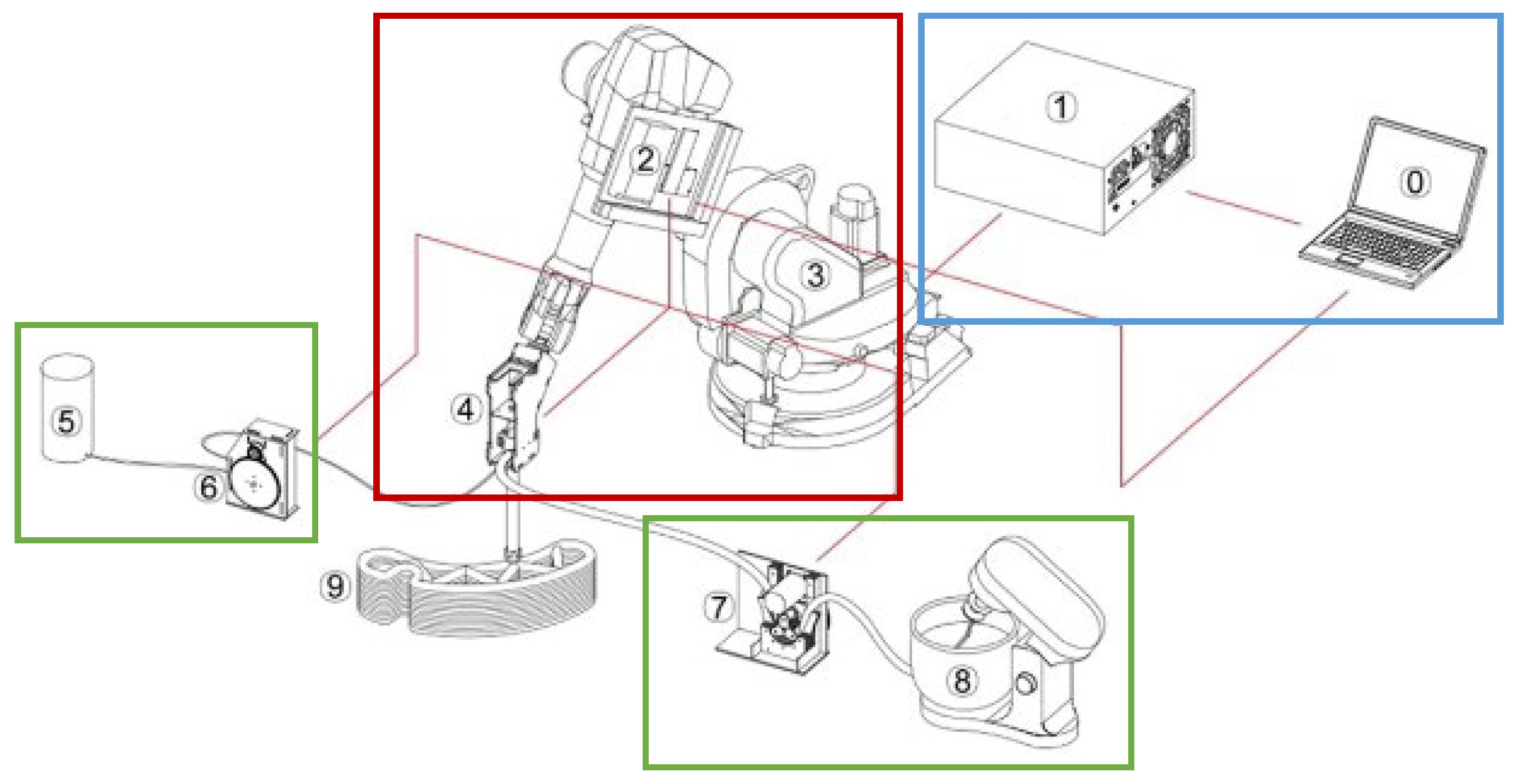
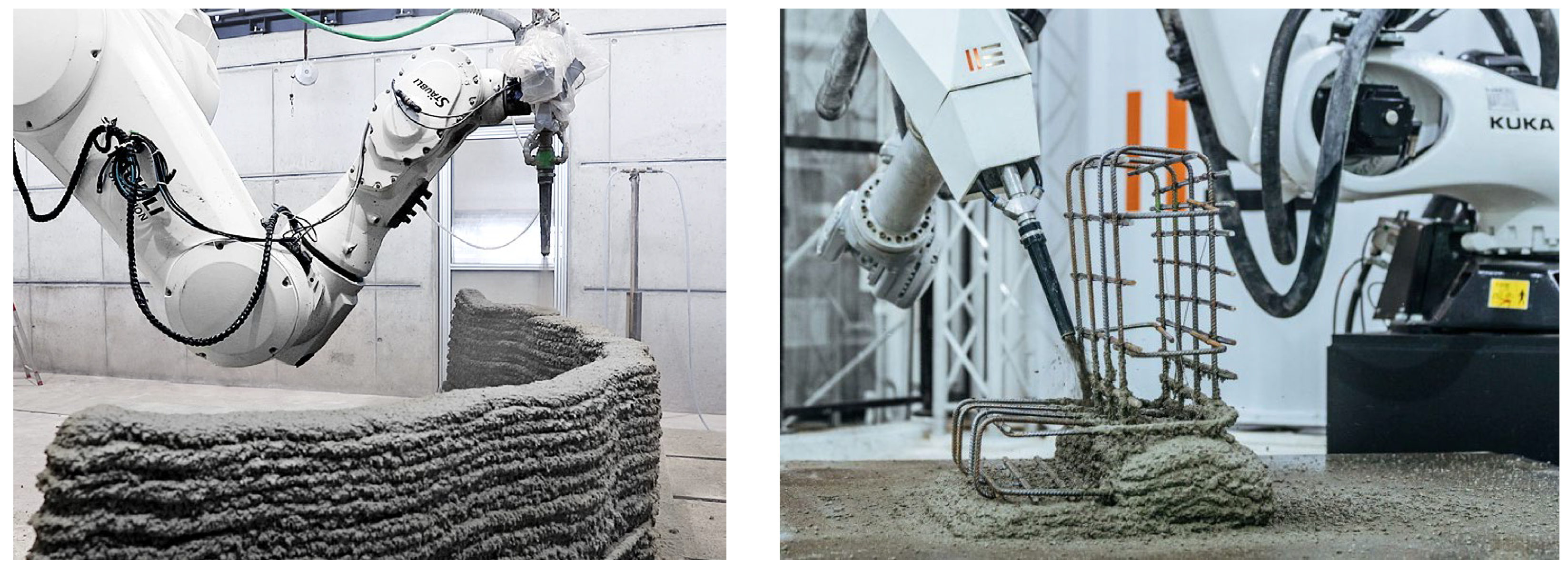


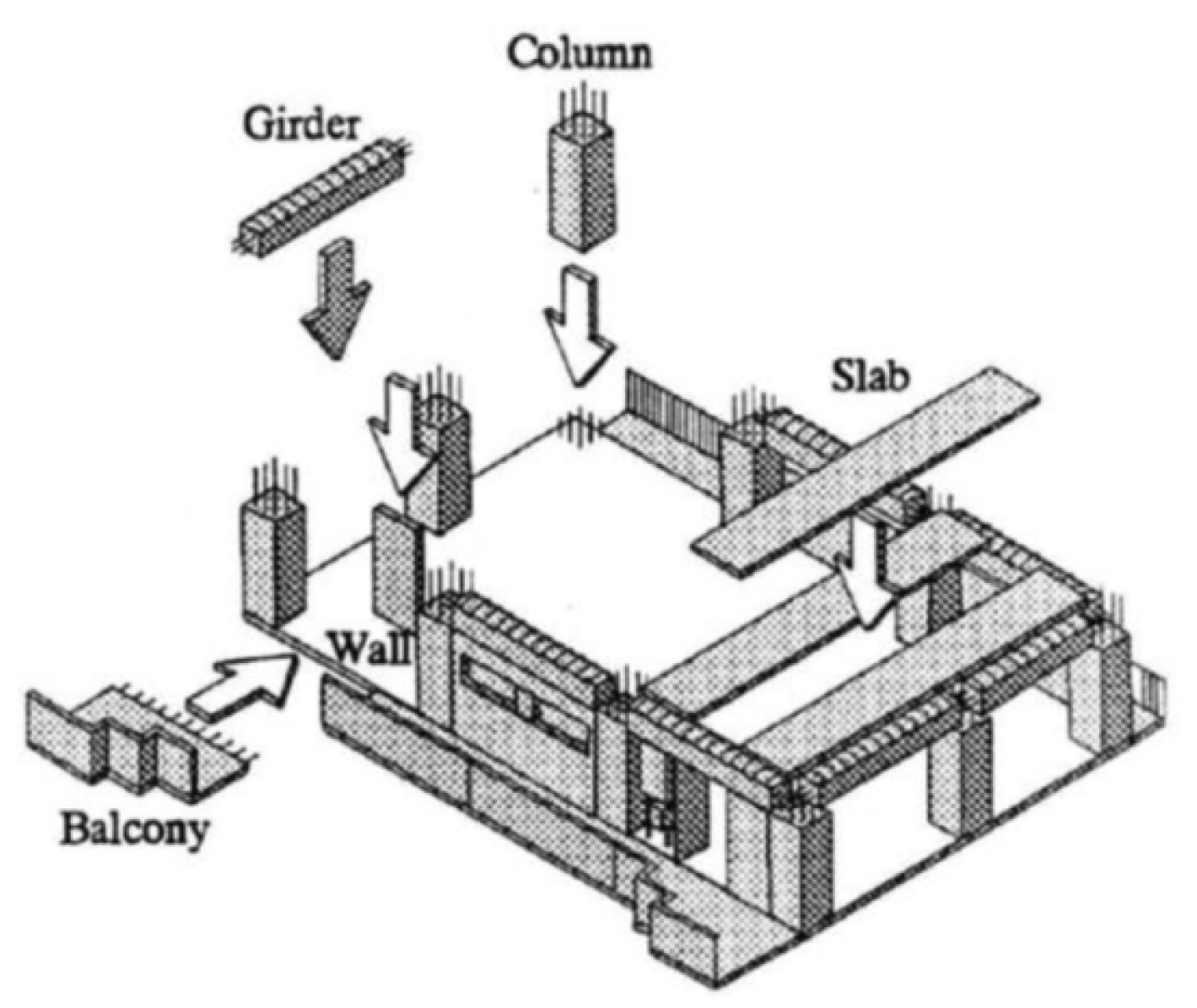



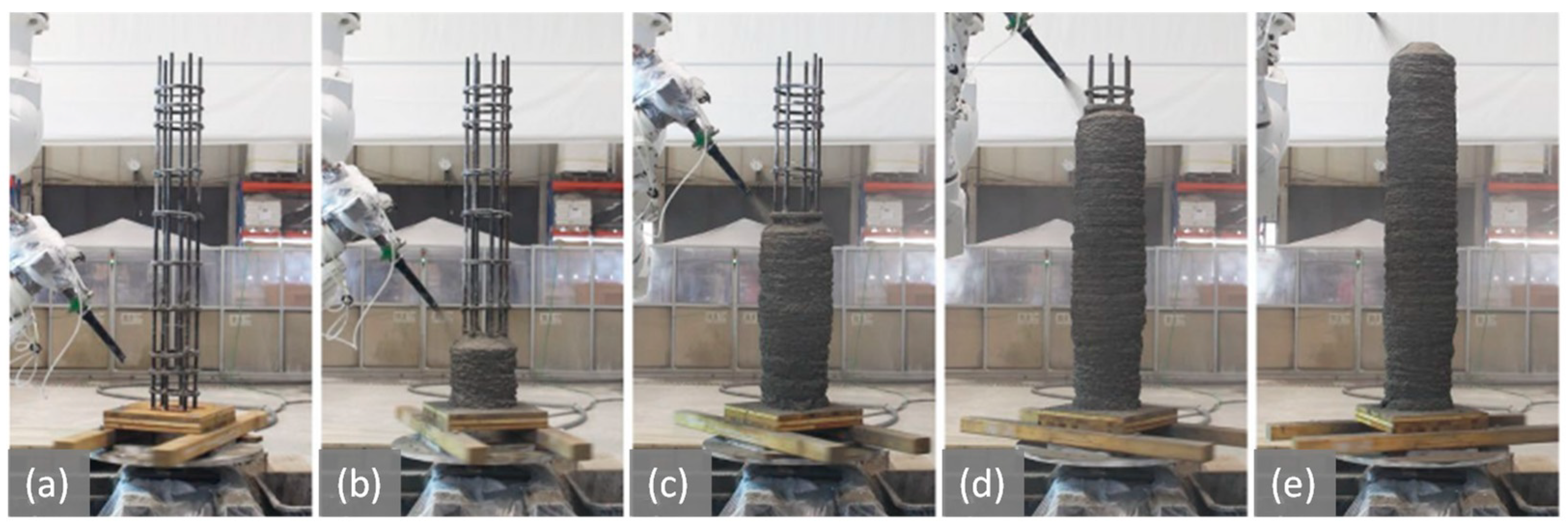









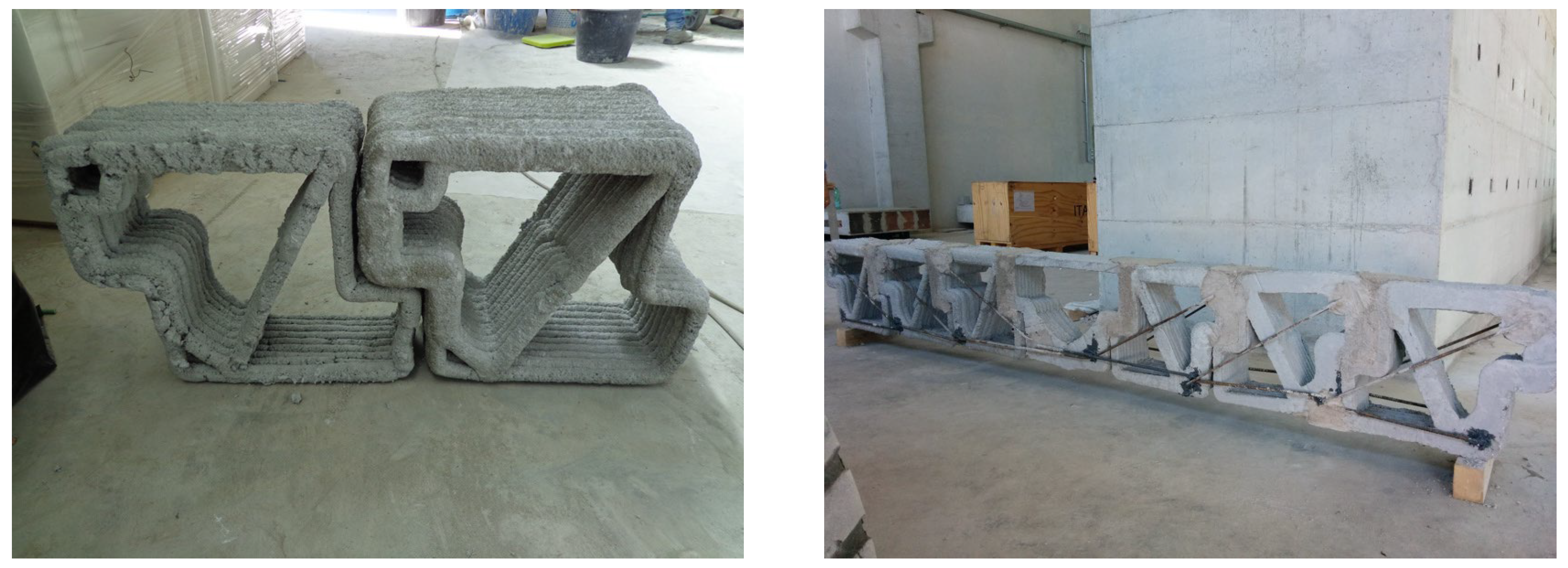

| Category * | Characteristic | Particle Bed | Extrusion | Spraying |
|---|---|---|---|---|
| Quantitative Characteristics | Particle Size | <1–5 mm [45] | 2–10 mm [54] | up to 2 mm [72] |
| Filament Width | (Depends on printer setup) | 4–10 mm, 10–50, >100 [50] | 100–200 mm [11,72,75] | |
| Filament Height | 1–5 mm [45] | 6–50 mm [54] | 10–20 mm [72,73,75] | |
| Printing Speed | 2–4 mm/min [85] (e.g., SCA) | 35–300 mm/s [54] | up to 250 mm/s [73] | |
| Qualitative Characteristics | Raw Material | Solid | Fluid | Fluid |
| Chamber | Yes | No | ||
| Compaction | e.g., Rotating Cylinder | Gravity | Kinetic Energy | |
| Degrees of Printing | 3D | 2,5D | 2,5D | |
| Support Structure | Yes | No | ||
| Printing Resolution | Very high | Medium | Low | |
| Geometric Complexity | High | Medium | Low | |
| Print Orientation | 0° (perpendicular) | 0° | 0°–90° | |
Disclaimer/Publisher’s Note: The statements, opinions and data contained in all publications are solely those of the individual author(s) and contributor(s) and not of MDPI and/or the editor(s). MDPI and/or the editor(s) disclaim responsibility for any injury to people or property resulting from any ideas, methods, instructions or products referred to in the content. |
© 2023 by the authors. Licensee MDPI, Basel, Switzerland. This article is an open access article distributed under the terms and conditions of the Creative Commons Attribution (CC BY) license (https://creativecommons.org/licenses/by/4.0/).
Share and Cite
Placzek, G.; Schwerdtner, P. Concrete Additive Manufacturing in Construction: Integration Based on Component-Related Fabrication Strategies. Buildings 2023, 13, 1769. https://doi.org/10.3390/buildings13071769
Placzek G, Schwerdtner P. Concrete Additive Manufacturing in Construction: Integration Based on Component-Related Fabrication Strategies. Buildings. 2023; 13(7):1769. https://doi.org/10.3390/buildings13071769
Chicago/Turabian StylePlaczek, Gerrit, and Patrick Schwerdtner. 2023. "Concrete Additive Manufacturing in Construction: Integration Based on Component-Related Fabrication Strategies" Buildings 13, no. 7: 1769. https://doi.org/10.3390/buildings13071769
APA StylePlaczek, G., & Schwerdtner, P. (2023). Concrete Additive Manufacturing in Construction: Integration Based on Component-Related Fabrication Strategies. Buildings, 13(7), 1769. https://doi.org/10.3390/buildings13071769










